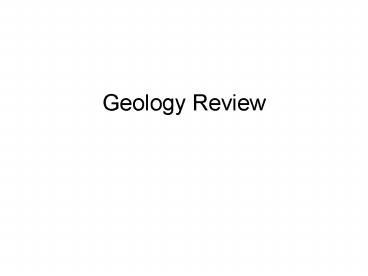Geology Review PowerPoint PPT Presentation
Title: Geology Review
1
Geology Review
2
The earth zone with the most volume and mass is
the
- lithosphere.
- core.
- crust.
- mantle.
- oceanic crust.
3
The asthenosphere is
- the outer atmosphere.
- the inner core of earth.
- a plastic region in the crust.
- a plastic region in the mantle.
- a solid region in the mantle.
4
The majority of earthquakes and volcanoes occur
- in the interior of continents.
- on oceanic islands.
- along the edge of continents.
- in the open ocean.
- In the U.S.
5
A ____ is not one of the three types of
boundaries between lithospheric plates.
- transform fault
- mantle fault
- convergent plate boundary
- divergent plate boundary
- lithosphere fault
6
Which of the following is false? Tectoni
- produce mountains.
- are composed of crust and core.
- move on the asthenosphere.
- produce ocean trenches.
- produce volcanoes
7
Tectonic plates move apart in opposite directions
at a(an)
- divergent plate boundary.
- transform fault.
- convergent plate boundary.
- subduction zone.
- mantle fault.
8
Tectonic plates move in opposite but parallel
directions along a fault at a(an)
- divergent plate boundary.
- transform fault.
- convergent plate boundary.
- subduction zone.
- mantle fault.
9
The energy sources primarily responsible for
earth's external geological processes are
- energy from the sun and magnetism.
- energy from the sun and gravity.
- energy from the sun and heat from earth's
interior. - gravity and magnetism.
- only gravity.
10
An earthquake is most directly caused by
- the creation of a fault (fracture in rock) or
shifting along an existing fault. - a change in ocean currents.
- dumping of toxic wastes.
- comets crashing into earth.
- mining.
11
Which of the following is not a characteristic of
a mineral?
- crystal structure
- organic
- naturally occurring
- solid
- inorganic
12
All of the following are broad classes of rock
except
- sedimentary.
- igneous.
- metamorphic.
- crystal.
- plasticized.
13
Lava is an example of ____ rock.
- metamorphic
- igneous
- sedimentary
- plasticized
- crystal
14
The change of rocks from one type to another is
known as
- metamorphism.
- the rock cycle.
- petrography.
- consolidation.
- hydrogeology.
15
Igneous rocks
- are an important source of many non-fuel mineral
resources. - include limestone and shale.
- are always formed on the surface.
- include schist and gneiss.
- can be derived from plant remains.
16
The type of rock that covers most of earth's land
surface is
- metamorphic.
- igneous.
- sedimentary.
- gemstones.
- plasticized.
17
Heat and pressure convert
- igneous rock into sedimentary rock.
- sedimentary rock into metamorphic rock.
- metamorphic rock into igneous rock.
- sedimentary rock into igneous rock.
- metamorphic into sedimentary rock.
18
Slate, anthracite, and marble are ____ rocks.
- primary
- secondary
- metamorphic
- igneous
- tertiary
19
A subduction zone is associated with a transform
fault.
- True
- False
20
The lithosphere is made of
- core and lower mantle.
- core and upper mantle.
- crust and lower mantle.
- crust and upper mantle.
- core and crust.
21
Soil is developed most directly through
- moving tectonic plates.
- earthquakes.
- weathering.
- mass wasting.
- volcanoes.
22
Leaching occurs when
- humus is dissolved.
- water removes soluble soil components.
- organic compounds slowly decay.
- rock is shattered by frost action.
- water stays in the soil.
23
Topsoil that is ____ in color is the most highly
fertile.
- gray
- red
- dark brown or black
- yellow
- green
24
Red and yellow colors in a soil horizon usually
indicate a
- high percentage of sand.
- high percentage of lime and gypsum.
- lack of iron oxide.
- low organic matter content.
- large number of soil organisms.
25
A soil sample of closely packed pebbles that is a
mixture of minerals and low in humus probably
came from a
- coniferous forest.
- desert.
- deciduous forest.
- tropical forest
- grassland.
26
Clay has ____ permeability and ____ porosity.
- high . . . high
- high . . . low
- low. . . high
- low. . . low
- medium . . . medium
27
Soil textures with moderate physical and chemical
properties include
- clay and silt.
- sand and loam.
- clay and loam.
- silt and loam.
- sand and clay.

